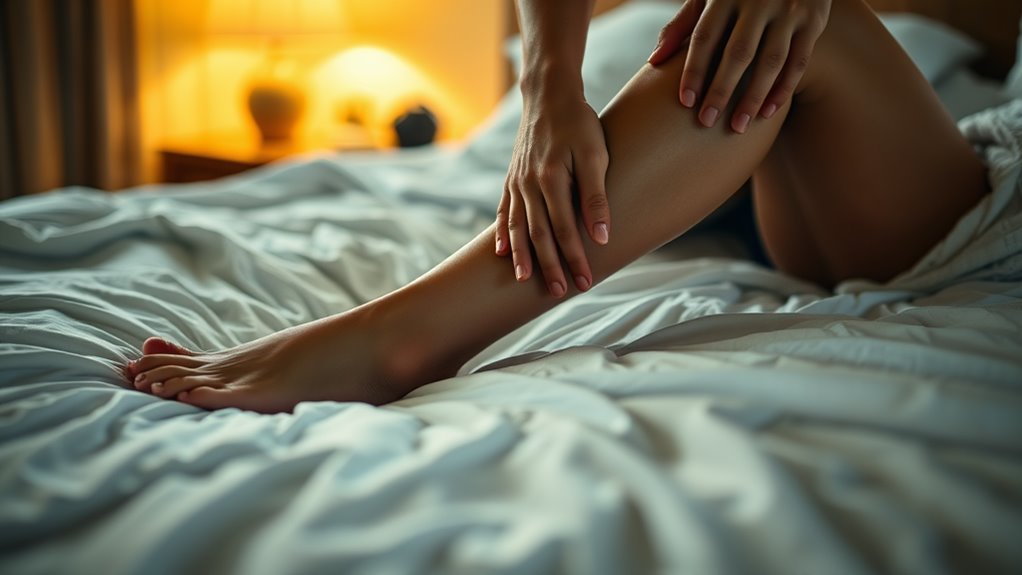These Easy Nighttime Moves Calm My Restless Legs
When restless legs strike at night, you can calm the tingling and twitching through specific movements and techniques. Start with gentle calf stretches by pulling your toes toward your shins, then perform circular massage motions from ankle to knee. Time these exercises 1-2 hours after dinner, ideally between 7:00-8:30 PM. For best relief, combine stretches with a warm bath 60-90 minutes before bed. Understanding the science behind these techniques will enhance your success with symptom management.
What Causes the Tingling and Twitching at Night
Your brain’s dopamine levels naturally decrease at nighttime, disrupting nerve signals that control muscle movement. This chemical imbalance can trigger uncomfortable sensations that help explain restless leg syndrome. Genetics, iron deficiency, and certain medications may also contribute to these symptoms, making it difficult to find relief without proper intervention. Understanding RLS can help in recognizing the condition and managing its impact on your sleep.
The Best Time to Do These Gentle Exercises
You’ll find best relief from restless legs syndrome by timing your gentle exercises strategically during three key windows.
The post-dinner period, typically 1-2 hours after your evening meal, provides an ideal opportunity to engage in these movements before fatigue sets in.
When symptoms first emerge, or just before your usual bedtime routine, you can also perform these exercises to help reduce the characteristic sensations and promote better sleep. Additionally, incorporating iron-rich foods into your diet can further enhance the effectiveness of these exercises in alleviating RLS symptoms.
Before Going to Bed
Three hours before bedtime is the ideal window to perform gentle exercises for restless legs syndrome (RLS).
This timing allows your body temperature to rise and gradually cool down, promoting better sleep.
You’ll want to avoid vigorous activity closer to bedtime, as it may increase dopamine levels and potentially worsen RLS symptoms during the night.
Post-Dinner Sweet Spot
When planning your evening RLS exercises, the ideal post-dinner window falls between 7:00 PM and 8:30 PM for most people.
This timing allows your digestive system to process the meal while maintaining ideal circulation.
You’ll want to avoid exercising too close to bedtime, as it can increase nervous system activity and potentially worsen RLS symptoms during sleep onset.
When Symptoms Strike First
Despite careful timing, RLS symptoms can sometimes strike unexpectedly during the evening hours.
When discomfort begins, immediately start these proven movements:
- Rotate each ankle in slow, controlled circles for 30 seconds
- Flex and point your toes in sets of 10 repetitions
- Perform gentle knee lifts while seated, 15 per leg
- March in place for 2-3 minutes to stimulate circulation
Simple Stretches You Can Do in Bed
Stretching your legs while lying in bed can provide immediate relief from restless legs syndrome (RLS) symptoms. Try pulling your toes back toward your shins for 30 seconds to stretch your calf muscles. Next, flex your ankles and point your toes downward. You can also perform gentle knee bends, drawing each knee toward your chest while keeping your lower back flat. Additionally, these stretches can help improve circulation and reduce symptoms, which are important for managing RLS effectively.
Massage Techniques That Bring Quick Relief
When restless legs disrupt your sleep, targeted massage can provide rapid relief through two primary techniques.
You’ll want to begin with gentle kneading motions using your thumbs and fingertips, applying moderate pressure in circular patterns on your calf muscles and thighs.
Follow this with upward rolling strokes from ankle to knee, using the palms of your hands to stimulate blood flow and reduce muscle tension. Additionally, incorporating regular physical activity into your routine can significantly enhance the effectiveness of these massage techniques.
Gentle Kneading For Comfort
Massaging your legs with gentle, deliberate pressure can provide immediate relief from restless legs syndrome (RLS) symptoms.
Apply these clinically-proven kneading techniques:
- Use your thumbs to create small circular motions along your calf muscles
- Press firmly into trigger points behind your knees
- Stroke upward from ankles to thighs with medium pressure
- Gently squeeze and release muscle groups for 30 seconds each
Rolling Strokes Up Legs
Rolling strokes deliver targeted pressure and movement that stimulates circulation while soothing tense leg muscles affected by RLS.
Starting at your ankles, use your thumbs to roll firmly upward along your calves in parallel strokes.
Apply steady pressure as you work toward your knees, focusing on the gastrocnemius muscle.
Continue this rolling motion up through your thighs, maintaining consistent pressure to promote blood flow and muscle relaxation.
Building a Soothing Bedtime Routine
A consistent bedtime routine plays a crucial role in managing Restless Legs Syndrome (RLS) symptoms and promoting better sleep quality.
Establish these evidence-based practices:
- Take a warm bath 60-90 minutes before bed to regulate core body temperature.
- Dim lights progressively over 30 minutes to increase melatonin production.
- Practice gentle stretching or yoga poses specifically targeting leg muscles.
- Maintain the same sleep-wake schedule, even on weekends.
Additionally, incorporating lifestyle changes such as regular physical activity can significantly enhance the effectiveness of your nighttime routine.
When to Seek Professional Help for RLS
When symptoms of Restless Legs Syndrome begin interfering with your daily life or sleep quality, it’s essential to consult a healthcare provider for proper evaluation and treatment. Watch for these key indicators that signal it’s time to seek medical intervention:
| Warning Sign | Frequency | Action Required |
|---|---|---|
| Sleep Disruption | Nightly | Immediate Consult |
| Daytime Fatigue | Daily | Within 1 Week |
| Mood Changes | Weekly | Within 2 Weeks |
| Movement Urges | Hourly | Immediate Consult |
| Depression Signs | Persistent | Within 1 Week |
